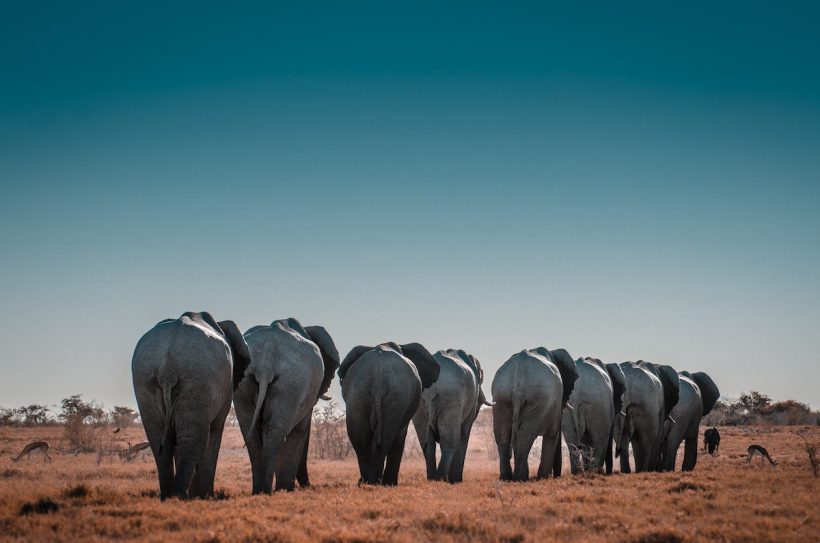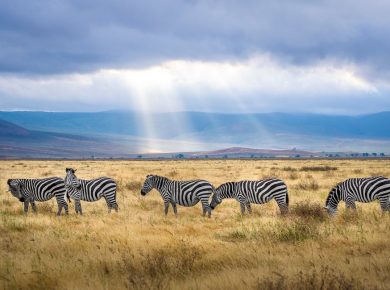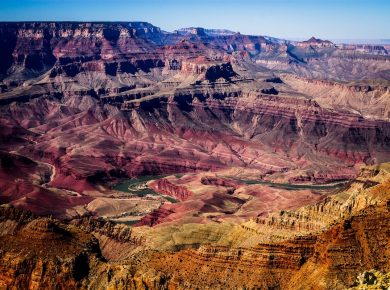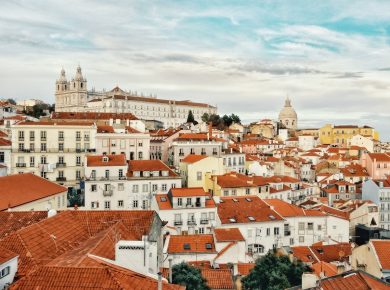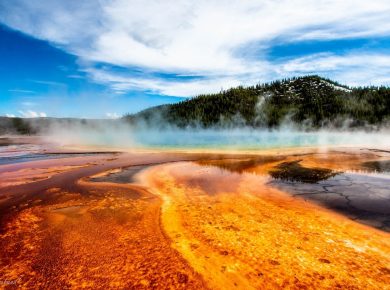It’s time for a vacation and you want to go somewhere totally unique and different from home. You chose the republic of Namibia. Congratulations! Located in southern Africa, the country has endless landscapes and wildlife that should be on any serious nature lover’s bucket list. Colossal red dunes and endless Savannah grasslands with wildebeests await the adventurous travelers who visit this country. However, when is the best month to visit Namibia?
The best months to visit Namibia are in the shoulder season months of April, May, September, and October. You will experience pleasurable weather and as well as score travel deals.
Namibia’s location makes it a tricky destination, as direct flights to the capital, Windhoek are limited and often pricey. Southern African cities like Johannesburg and Cape Town have regular connections, but beyond these, Frankfurt and Doha are among the only hub cities with direct routes.
The season can make or break your trip, too. Coming from Europe or North America? Remember that Namibia’s seasons are the reverse of ours, so a getaway during the holidays will bring blistering, dry heat. Escaping the frosty winter climate found back home may seem like a nice idea, but you’re going from one extreme to another.
The summer months (Namibia’s winter) have low precipitation and warm-yet-friendly temperatures. It should be no surprise that this is when the country’s tourist industry is most swamped! Safaris are booked up and hotel deals evaporate like a desert mirage.
This article assesses the average weather and tourist season trends to determine the best month to visit Namibia for good weather and low prices. To do this, we will look at four cities spread throughout the country: Windhoek in the northeast, Keetmanshoop in the southeast, and coastal cities Walvis Bay and Lüderitz.
Table of Contents
Average Temperature In Namibia
Namibia’s iconic deserts only cover 16% of the country’s territory. Still, it hardly ever gets cold weather, and its seasons are better described as the hot season and the warm season. The temperature at any given time varies drastically based on geography, too. While inland communities are all but on fire with desert temperatures, people on the coast are enjoying balmy, spring-like conditions.
Keetmanshoop is the hottest city with a high of 95°F and a low of 69°F in January, the summer’s peak. Windhoek isn’t far behind with a range of 88°F to 65°F in December, its hottest month.
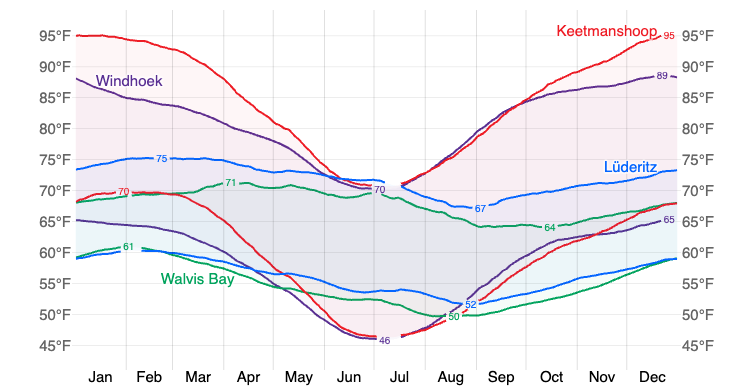
At the same time, Walvis Bay and Lüderitz feel like summer resorts by comparison with temperatures ranging in the 60s and low-to-mid 70. These temperatures rarely leave this range throughout the year, only dipping to the lower 60s and 50s in September and October.
Keetmanshoop and Windhoek, on the other hand, undergo huge changes with the seasons. June and July, Namibia’s winter months, see average highs in the low 70s and lows in the upper 40s in the inland cities.
Spring and autumn significantly cool and then warm up the inland cities which causes a difference of 30°F between the summer and winter seasons in Keetmanshoop and Windhoek. Walvis Bay and Lüderitz, hardly change and maintain balmy temperatures year-round.
Daily Chance Of Precipitation In Namibia
Despite their location in or near the desert, some Namibian cities see significant precipitation. Others get almost no rainfall all year. Cities with rainy seasons sometimes experience flooding, so it’s essential to plan your visit to ensure comfort and safety.
Walvis Bay and Lüderitz have low, nearly nonexistent average rainfall all year. Walvis Bay’s wettest months are March and April with an average of 0.2 inches of rainfall each. Lüderitz never receives more than 0.1 inches.
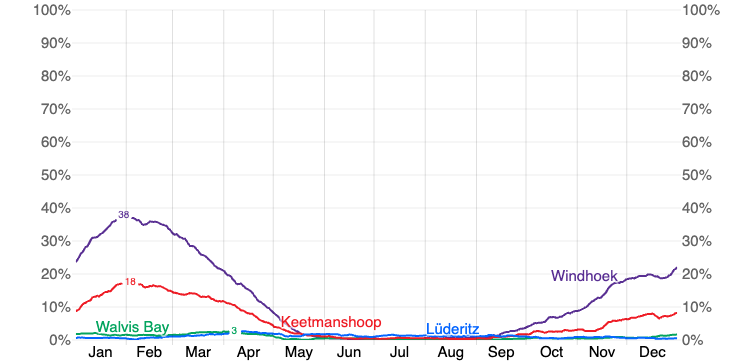
Windhoek and Keetmanshoop, on the other hand, have wet weather. September through May sees varying amounts of rainfall in the two cities. Windhoek is Namibia’s rainiest city with a peak average rainfall of 3.4 inches in February. You can expect almost 10 wet days here in both January and February.
Keetmanshoop’s rainfall also peaks in February, but with only 1.3 inches on average. It only gets about 4 wet days in January and February.
If rain is your worst enemy, consider visiting during Namibia’s winter. June through August is a nationwide dry season. No city gets more than 0.1 inches in these three months.
Humidity Comfort Levels In Namibia
Hot temperatures do not always equal muggy weather, and Namibia is for you if you don’t like humidity! There is a slight humid season, but it’s hardly worth worrying about.
Walvis Bay has the highest chance of muggy weather with a peak 9% chance in February. Keetmanshoop is the only other city with a chance of humidity higher than 1%, with a 3% peak in late January.
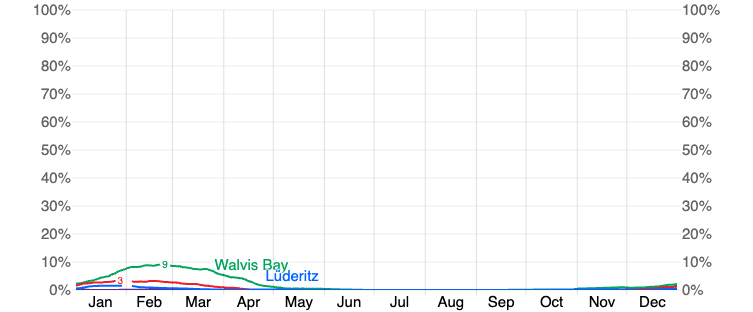
Namibia’s dry heat is no joke, but luckily humidity is one less problem you’ll have when visiting!
Best Time Of Year To Visit Namibia For Great Weather
Namibia’s weather is extremely reliable. You know when it’s hot or warm and when you can expect rain.
Is there one perfect season to visit? It all depends on geography, as different regions sometimes experience different weather patterns. However, some seasons have quite similar weather across the country, so it’s important to know these seasons to plan for the best, most consistent weather possible.
Two factors are used to decide the best months for weather: the “tourism score” and the “beach/pool score,” respectively. The first is used to determine how pleasurable outdoor activities like sightseeing tours are in a given month. Clear skies and temperatures between 65°F and 80°F are the criteria here.
All four cities score well on the tourism score criteria, and some have high scores year-round.
Walvis Bay and Lüderitz, having consistent temperatures, also have high tourism scores across the board. Lüderitz is best visited in mid-January with a tourist score of 9.1, the highest of the four. Mid-March is best for Walvis Bay with an 8.2 score.
Windhoek and Keetmanshoop’s tourist scores fluctuate more, but they never score poorly. Both score 8.5 in mid-April, creating a good window to visit both cities. Windhoek scores slightly higher in September with 8.7, Keetmanshoop being close behind.
The “beach/pool score” favors clear, sunny days with temperatures ranging between 75°F and 90°F.
Walvis Bay and Lüderitz score lower here due to their temperatures peaking in the low 70s. None of the cities are beach/pool score-friendly in June or July.
Outside the Namibian winter months, Windhoek and Keetmanshoop are high scorers on the beach/pool scale. The former peaks in October at 7.6 and the latter in December at 8.6.
The best months to visit Namibia for great weather are the shoulder seasons and winter, April through October. All cities score relatively well on the tourism and beach/pool scores, making a nationwide trip easy and comfortable.
Best Time Of Year To Visit Namibia For Low Prices
Namibia’s distance from hub airports makes it a tricky (and expensive!) place to reach. Moreover, due to a lack of resources, most food and products are imported, making the cost of basics considerably high. How can you make this trip as budget-friendly as possible?
It’s possible to save some if you plan carefully. Booking several months in advance and avoiding busy seasons will help you secure a good fare. A spur-of-the-moment getaway to Namibia will be extremely costly no matter the time of year.
Another major saver for those coming from afar is traveling to Johannesburg. From there, long-distance buses can take you on a 20-hour bus ride to Windhoek via Gaborone, Botswana for as cheap as $65. This is a great travel hack if you have the time, as flights to Johannesburg from Europe are sometimes $300-400 cheaper than to Windhoek.
Namibia’s off-season, December to March, offers the lowest prices to potential visitors. Flights, though ever expensive, can drop up to 15% in cost.
Your biggest savings will be on accommodation and tours if you choose to book them. Hotels slash their prices as a reward to those bold enough to brave the summer heat. Rooms in Windhoek are sometimes several hundred dollars less per night in January than in July.
Tour prices are often 20-25% lower per person than those during peak season. Depending on the type of package you select, that could mean several thousand dollars in savings.
Peak Travel Season In Namibia
Namibia’s long peak season, lasting from April to October, is the most favorable time to visit. Temperatures decrease dramatically but stay warm, and there’s almost no threat of precipitation.
Though this season attracts the most tourists, you’ll likely only notice it in cities like Windhoek due to the vastness of the country.
Don’t be surprised if you have to pay over $1,000 to fly from the USA during this period. The route involves at least two long-haul flights with connections to Frankfurt, Doha, Johannesburg, or Cape Town.
The country offers a diverse array of accommodation options, from international chain hotels to private cabanas in the Savanna grasslands. These options become scarce and more costly the closer you get to peak season though.
A room at the Windhoek Hilton will run you about $500 per night for a July stay. However, if you book a few months ahead of time, the same dates drop to $300 per night.
Safaris and nature tours, easily the biggest draw for tourists, are most available at this time. Just expect to pay a lot more! A 10-day luxury package tour for two costs $8,750 in the off-season, but up to $10,900 in the winter!
These prices are usually fixed according to the provider and don’t fluctuate like flights and hotels. However, you can scour your options to find the best deal and contact guides directly.
Shoulder Travel Season In Namibia
A visit during Namibia’s two shoulder seasons, April-May and September-October, still offers impeccable weather conditions as well as chances to save!
Both periods are slightly warmer than the peak season and only slight chances of precipitation. You can expect to stay warm and dry, and will only need a coat for nighttime in the desert.
Flight prices tend to match those of peak season, so still expect to pay around $1,000 or more during this time.
Though airfare may not change, there are plenty of opportunities to save on accommodations and tours! Tourism is still popular in these months but there’s a significant decrease from June and July.
Accommodations are widely available during shoulder season and decreased demand leads to savings on rooms. A nice hotel in Windhoek may cost between $200 and $300. Apartments and homestays rented through platforms like Booking and Airbnb are even cheaper.
A night at a private apartment in the capital may only cost you $60 per night. While some tour providers include these months in peak season prices, some consider them off-season and offer slashed prices. These tours sometimes cost up to $2,000 less than if you went in June or July.
Low Travel Season In Namibia
Namibia’s off-season from December through March offers all of the beauty and charm that can be found the rest of the year for those who can handle the heat. Discounts on flights, accommodation, and tour packages are also abundant.
Flights are definitely at their cheapest here, and January is said to have the best deals. Roundtrip flights from Frankfurt are about $600. Connections from Johannesburg drop to $300, compared with their usual rate of $500 and up.
Hotels usually slash their prices, and visitors spend about $400 less on bookings at luxury hotels and game lodges than peak season travelers. More frugal options like apartments or spare rooms can cost less than $100 per night.
The summer heat is no joke. In inland areas like Windhoek, Keetmanshoop, and national parks like Etosha, temperatures frequently surpass 90°F. However, tour providers usually combat the heat with air-conditioned transportation and accommodation. Most of the same tours offered in peak season are still available here.
Depending on the package and amenities included, you can pay between $2,000 and $6,000 per person. However, compare this with peak prices from the same companies and you’ll notice you’re saving between $500 and $2,000 per person.
Best Months For Travel To Namibia
There’s hardly a bad time to visit Namibia. Though heat can be troublesome, the locals have modern comforts to avoid it. Each season has unique opportunities for exploring the countryside’s abundant wildlife. However, some seasons possess the perfect balance of nice weather and low prices that make them the best time to visit Namibia.
A low-season visit promises the biggest discounts and smallest crowds. However, it may be hard to enjoy oneself on the dunes when it’s over 100°F or flooding in the streets outside the hotel.
Traveling in the shoulder season months of April, May, September, and October are your best chances of getting both good weather and scoring deals. Visiting in either period allows you to avoid rain and extreme heat.
Both seasons are also known to have smaller crowds and more accommodation options than in the summer peak season. Furthermore, tour packages often already have low season prices as providers want to entice the diminished tourist population to choose their company.
